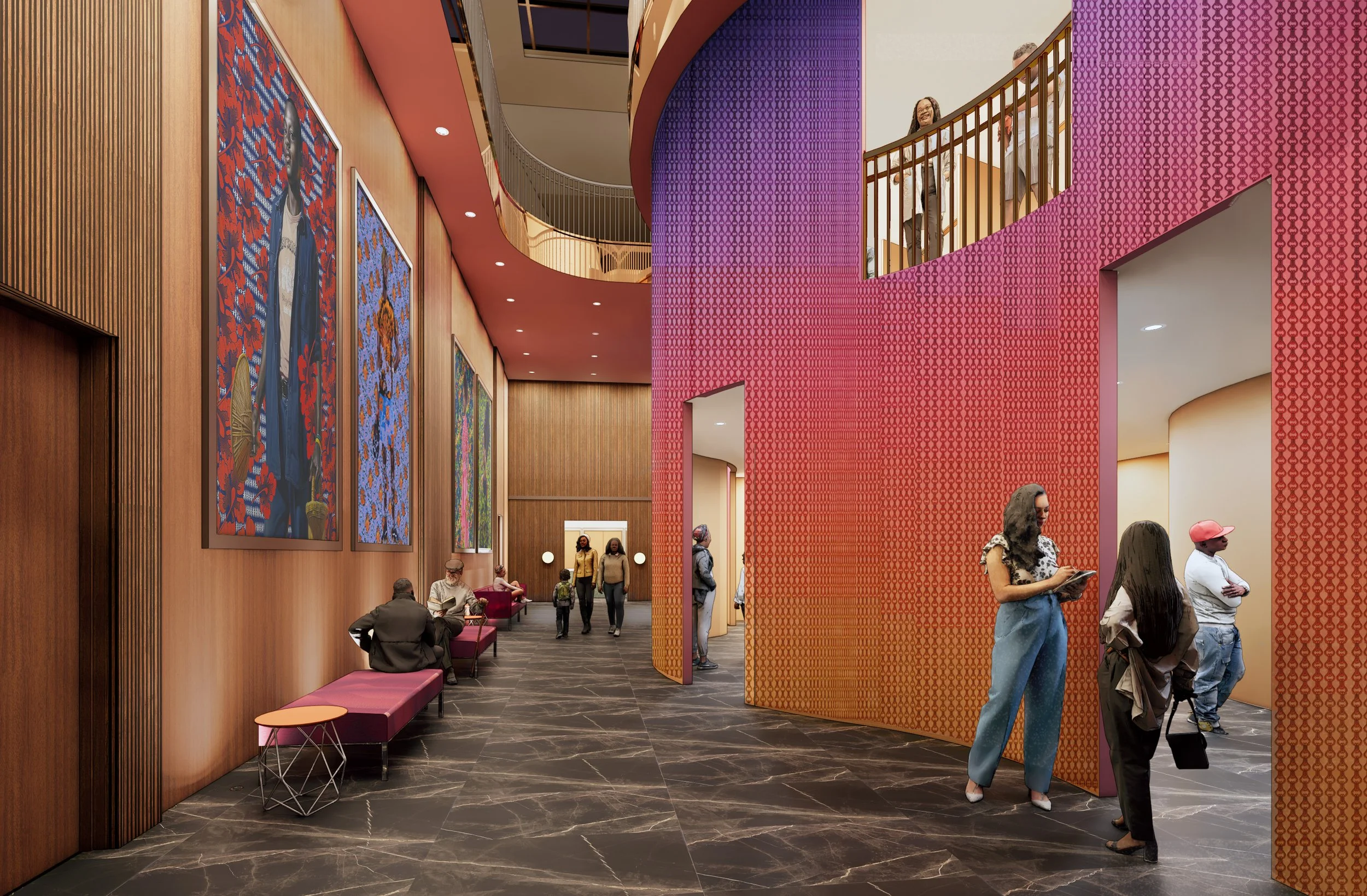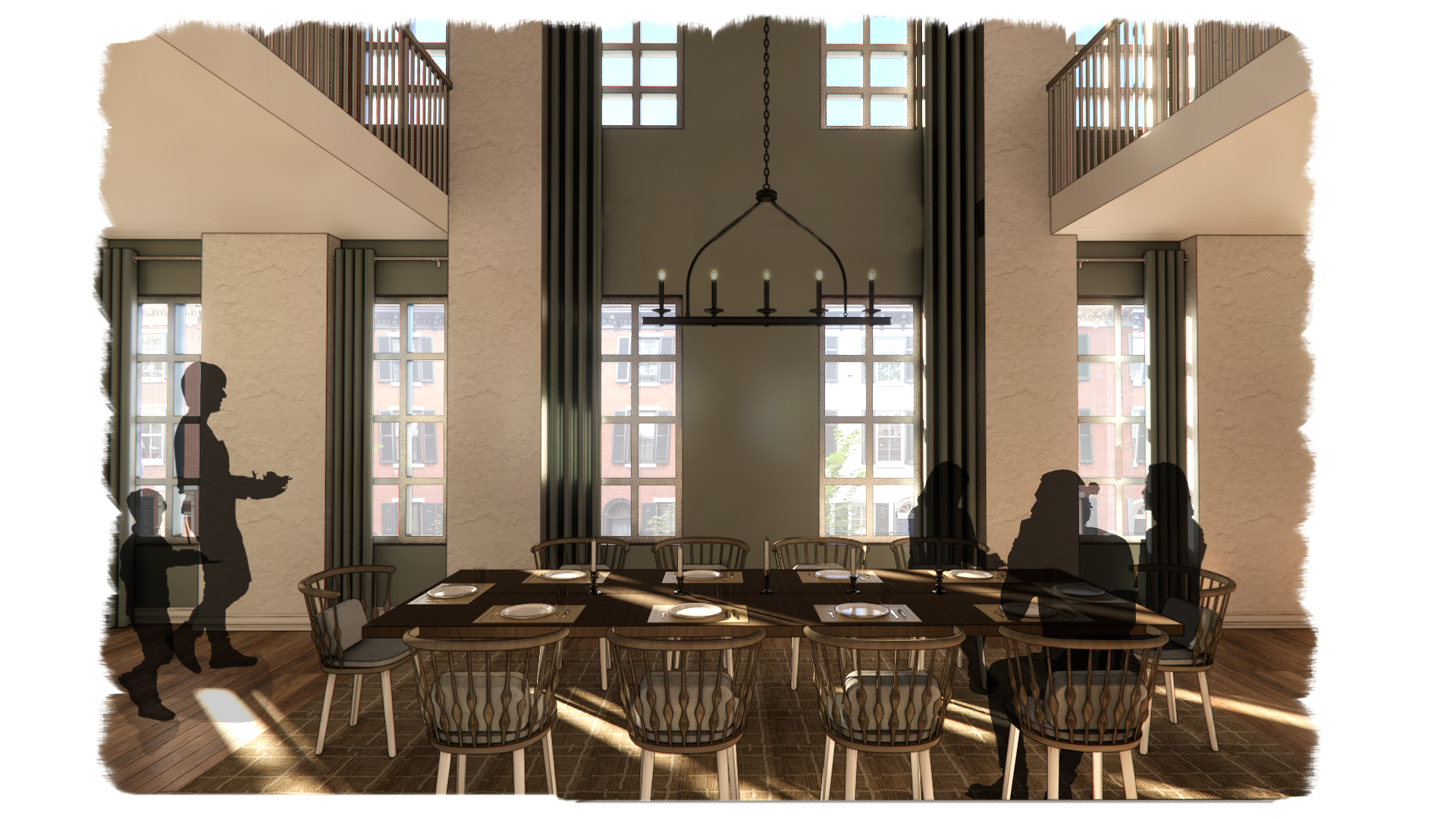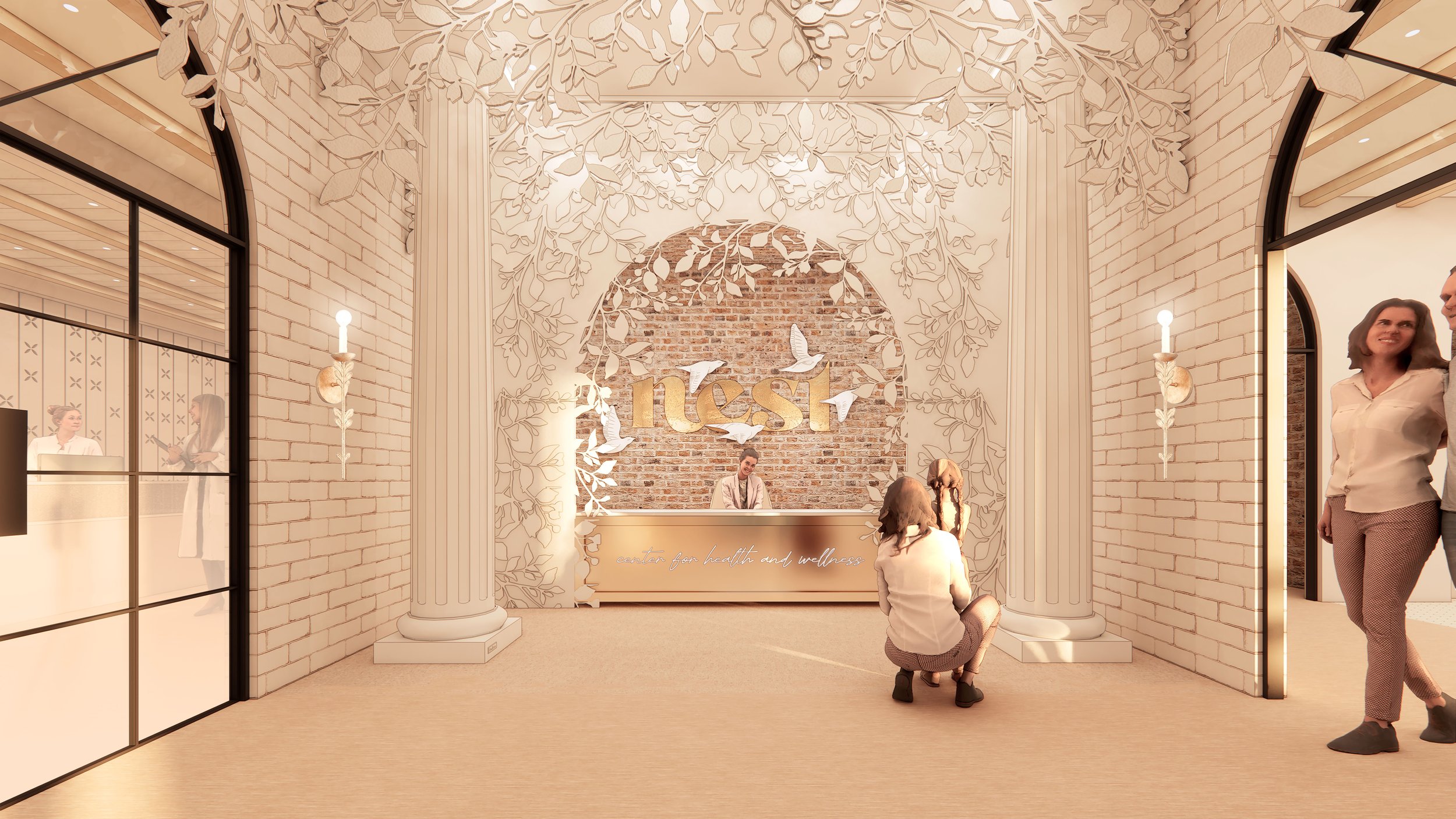Thesis Projects
Thesis Projects by Year
The Living Mosaic: Celebrating Urban Interiors Through Food, Nature, and Community
Set in a historic church in Philadelphia’s Italian Market neighborhood, The Living Mosaic is a gathering place designed to reflect the energy, diversity, and culture of its community. This project explores how creative interior environments can support meaningful connection by integrating food, drink, and play into everyday life. Community kitchens, a coffee-to-wine bar, workshops, and active zones foster joy and a deep sense of belonging. Vertical gardens, an outdoor wine garden, community garden beds, and a neighboring pocket park blend nature into the experience. The design encourages lingering, learning, and spontaneous interaction across generations and backgrounds. In contrast to the fast pace and isolation of urban life, The Living Mosaic creates an inclusive, welcoming environment where people feel supported and connected to something greater. It is a celebration of everyday moments, neighborhood rhythms, and the simple joy of being together.
Spatial Catalysts: Designing for Dignity and Healing in Women's Shelters
Many unhoused individuals avoid traditional shelters due to overcrowding and institutional designs that overlook their emotional and psychological needs. In cities, the limited availability of supportive environments further reinforces cycles of isolation and invisibility. This thesis examines how interior architecture can serve as a transformative tool,creating spaces that restore dignity, safety, and belonging.Focusing specifically on shelters for women and single mothers, it explores how design can foster emotional healing and stability. By incorporating calming, nature-inspired palettes, soft textures, residential-scale furnishings, and spatial layouts that promote autonomy and privacy, the built environment can begin to undo the sense of exposure and powerlessness many residents feel. These design choices provide a setting for recovery, reflection, and growth. In creating spaces that prioritize safety both physically and psychologically, the project also emphasizes features such as clearly defined personal zones, secure entryways, warm lighting, and communal areas that encourage voluntary interaction rather than forced proximity. Through such details, the shelter becomes more than a temporary refuge;it becomes a space of dignity and hope, where women can begin to feel safe, seen, and supported in rebuilding their lives.
Cultural Identity and Design in Immersive Environments
As individuals increasingly seek culturally immersive and emotionally resonant experiences, this project explores how interior environments can celebrate identity without resorting to literal or stereotypical representation. Conceived as a contemporary oasis, the design offers a curated journey within a hospitality setting inspired by Middle Eastern culture – one that invites pause, reflection, and discovery. Rather than mimicking tradition, it evokes cultural memory through sensory storytelling, material richness, and spatial sequencing. The goal is to create an atmosphere that is both approachable and transportive, appealing to a broad audience, including those unable to experience such cultures firsthand. By navigating the space between authenticity and entertainment, the project proposes a design framework that honors cultural depth while prioritizing enjoyment, accessibility, and emotional impact.
Spatial Freedom: Unbound Black Joy
Black oppression is spatial, as it has always involved exposing us to harmful environments or denying us spaces for healing. To express ourselves, to take up space, and to move freely—to be, in whatever way we choose—is to resist that oppression. In response, Black leaders throughout history have created meaningful spaces that sustain our communities. These spaces often subvert traditional architectural limits, instead pursuing healing, liberation, and joy through their own design logic.
Sound and movement are central to these spaces, giving them vibrancy and expanding their meaning beyond their structural limits. In pursuit of Black joy, this project examines the sounds, motions, and creativity that shape Black spaces, and re-imagines them as architectural elements. In doing so, it transforms the built environment for our community's benefit.
Understanding Digital Nomads, Their Lifestyle, and Design Strategies to Enhance Their Experience
The digital nomad lifestyle, blending remote work with extensive travel, has grown exponentially over the past decade. While it offers unmatched freedom and flexibility, finding suitable infrastructure—like co-working spaces, Airbnb, and wellness-oriented environments—often requires significant time and effort. These elements are rarely integrated or located conveniently together, creating friction in an otherwise fluid lifestyle. Existing setups tend to prioritize function over experience, limiting opportunities for deeper connection with the space and its surroundings. By incorporating natural elements, engaging the senses, and allowing for individual customization, we can transform temporary spaces into immersive environments that support focus while inviting exploration. The concept of meandering—wandering through spaces that spark curiosity and reflection—can be embedded in design to enrich daily routines. Through biophilic design, sensory richness, and a reflection of local authenticity, we can create cohesive, inspiring spaces that not only meet the practical needs of nomads but also elevate their journey.
Hamilton Lofts: Home for Creative Expression on Avenue of the Arts
Art is both an individual and social practice. Individual, in that privacy allows the artist to reflect, focus, and experiment freely. Social, in that shared spaces like galleries, studios, and performance venues facilitate interaction and connection. A balance of these two environmental conditions is the crux of optimizing creative flow. Artists will always create despite limitations; however, this thesis examines how refining access to live-work space can benefit artists and musicians, with a focus on integrating communal areas to foster stronger connections with neighbors, and flexible private studio spaces that prioritize artists’ individual needs. Through considered porosity of views and customizable furniture kits, the design strategy aims to create thresholds that encourage informal exchange and lateral learning—where ideas are shared across disciplines and experience levels. These design decisions promote a culture of collaboration and a sense of belonging, establishing the foundation for a vibrant and connected creative community
The Prosper House at Cathedral Park
This thesis proposes a new model for affordable housing that supports long-term financial growth by allowing residents to pay reduced rent while advancing their careers. The design prioritizes economic mobility, giving tenants the time and space to focus on professional development and save money—ultimately enabling them to leave the housing program with higher incomes than when they entered. The project is built on three key principles: first, that people should be able to prosper financially without leaving their home communities; second, that affordable housing must provide comfortable, spacious living units to support resident wellbeing and foster community; and third, that amenities should not be viewed as luxuries, but as essential responses to resident needs. Amenity spaces are intentionally integrated throughout the design to offer meaningful support and enhance quality of life. This model reimagines affordability as a foundation for upward mobility, not just as a measure of cost.
Substance Addiction Recovery: Interconnecting Community, Environment, and Technology
Addiction is not merely a personal struggle; it is shaped by environmental and social forces that often lead to isolation and weakened community connections. In recovery, fostering social relationships is crucial, as shared experiences encourage openness and lasting bonds. Digital communities also play a vital role, enabling individuals to build meaningful connections across distances while expanding support networks and perspectives. This thesis introduces a new model for addiction recovery centered on community, connection, and healing. By integrating inpatient and outpatient care, it fosters stability and continuity, helping individuals build lasting relationships while easing transitions between structured support and independent living. By integrating technology and thoughtful design elements—fostering familiarity, safety, and a sense of control—this model creates environments that feel hopeful and empowering, reshaping recovery spaces into places of growth and optimism.
Sentenced to be Seen: Reinventing the Power Imbalance of Interior Surveillance Through Digital Voyeurism
This thesis investigates the role of interior design as a spatial storyteller, focusing on how environments shape perception, identity, and power dynamics. Drawing on examples from set design, entertainment architecture, and prison systems, it explores how design can both invite and restrict human experience. Central to this investigation is the Panopticon and its evolution from a tool of psychological control to a pervasive force in today’s digital surveillance culture. Using Eastern State Penitentiary as my intended site, the project proposes a conceptual reimagining of the prison as a participatory nightclub experience. Here, surveillance is transformed into play, encouraging guests to explore the tension between autonomy and observation. By reframing a site of isolation through the lens of collective nostalgia, evoking the intimacy and energy of house parties, the design challenges institutional narratives of control instead offering a space for reconnection, identity reclamation, and sensory liberation.
Children's Joyful Hospice Care to Feel Like Any Other Child
Children's hospice care is dedicated to providing compassionate and comprehensive support to children facing life-limiting illnesses with a prognosis of six months or less. This thesis proposes a groundbreaking design concept for children's hospice care, prioritizing individualized care and emotional support through the integration of nature, flexible spaces, vibrant aesthetics, and holistic sensory elements. By creating a sanctuary where children can rediscover the joys of childhood, even in the face of serious illness, the design aims to nurture the well-being of every child while providing unwavering support to families and caregivers. The proposed concept seeks to transform hospice care into a place of joy, comfort, and positive memories for both children and their families, emphasizing holistic sensory wellness, community engagement, and compassionate design principles.
Reflective Effect: Materiality Impact on Embodied Cognition in Experience Design
Exploring the relationship between humans and the environment by combining reflective materials and immersive design. This project focuses on how architectural/interior designs use reflective surfaces to transform spaces and explores the growing prominence of reflection in the human experience. These surfaces' symbolic and illusionary aspects blur the traditional boundaries between internal and external characteristics. It can bridge the gap between the occupants and the surrounding space and is a spatial phenomenon that allows people to observe themselves in their surroundings. Moreover, reflective materials in interior spaces create engaging and immersive user experiences by taking advantage of our embodied cognition. These materials aid in the physical body’s complete immersion in its environment. By designing intuitive interfaces responsive to our physical experiences, we can create more dynamic spaces that reflect our embodied experiences.
Mindful Consumption: A Rethinking of Shopping Experience
Consumerism is not only devastating our natural resources, but it also diminishes individual well-being. Rather than enhancing well-being, the expanding populations of high consumption societies are likely to have adverse effects. Even when we buy the things we really wanted, we start to want more. Fulfilling our desires never seems to satisfy us; we continually seek more happiness. Mindfulness is strongly and positively connected to higher happiness. In the context of consumption, mindfulness leads to consumer mindfulness. shopping is an activity that involves a range of practices such as experiencing public spaces, “hanging out,” and wandering around. As such, it can be understood as a leisure activity in its own right that does not necessarily involve the actual purchase of goods. I will explore various aspects related to habits, consumerism, sustainability, and the concept of a futuristic shopping experience that goes beyond traditional retail spaces, to provide education and encourage thoughtful consumption.
Beyond Shelter: Navigating the In-Between with Third Spaces for Individuals Experiencing Homelessness
Individuals experiencing homelessness exist in a dichotomy that is enforced by stereotypes and manifests in a limited scope of services, even in major metropolitan cities like Philadelphia. Homeless vs. Housed – it is a distinction that dictates the types of environments people can, or should, inhabit. For individuals experiencing homelessness, shelter is not the only solution. Spaces for the in-between, that are designed for a population in transition in order to help them heal, establish stability, and create networks within their communities, are missing. This project aims to bridge this gap through the design of an interconnected network of third spaces designed to support and empower individuals experiencing homelessness at three scales: individual, group, and community. Spaces that treat all people with dignity and respect, meeting people where they are currently instead of waiting for them to navigate crises alone, is an essential first step to fostering stronger, healthier, and more inclusive communities for all.
There’s No Place Like Home: Uniting Generations, Celebrating Cultures, and Embracing Expression
The foundation of my thesis is grounded through the central theme of the concept of “home” as it’s understood through the lens of cultural traditions. A person’s home acts as a source of emotional security, comfort, and a profound sense of belonging. It serves as the foundation for building relationships and creating memories. My thesis outlines a study that seeks to deepen our understanding of the concept of home through an exploration of cultural traditions passed down through generations. My thesis employs the theoretical framework of place-identity to examine how an individual’s sense of belonging is intertwined with their cultural heritage. By utilizing this concept, my thesis focuses not only to understand how cultural traditions contribute to individuals' sense of place-identity but also to actively create a space for the exchange and preservation of these traditions. This space is envisioned as inclusive and welcoming, fostering intergenerational dialogue and the sharing of personal narratives among individuals who share similar cultural values.
Beyond Birth: Crafting Supportive Postpartum Environments
There are 3 million pregnant women in the United States each year, and many feel like candy wrappers: packaging to be discarded after use. American apathy towards the female experience after birth is reflected in our lack of standardized postpartum care. This has contributed to one of the highest maternal death rates among the developed world, with more than half occurring after birth. According to the WHO, many of these deaths are preventable with proper postpartum care. This thesis explores the role of interior design in providing this crucial support, aiming to improve outcomes for both mothers and infants.
Unlocking Creativity: The Transformative Influence of Playscape Facilities on Children’s Emotional, Cognitive and Identity Making
In the times where children are increasingly engaging in less physical play, my thesis focuses on the immersive integration of children in environments that prioritize exploration and creativity through the strategic design of 'Playscape' facilities. These purposefully crafted environments play a crucial role in fostering imagination, problem-solving skills, and overall cognitive and emotional development during the critical early years of a child's life. The profound link between physical spaces, furniture, and developmental outcomes underscores the importance of creating spaces that actively promote creativity and contribute significantly to a child's holistic growth. Moreover, these playscapes serve as inclusive spaces where parents can spend quality time with their children, fostering a strong parent-child bond and supporting the child's development in a shared, nurturing environment.
Recreating Episodic Memories Through Immersive Environments
This thesis investigates how architectural design elements evoke emotional responses, influence the encoding and retrieval of episodic memories, and engage sensory perception within built environments. By analyzing the impact of spatial configuration, lighting, materials, colors, and sensory stimuli on emotional experiences, the research aims to elucidate the mechanisms underlying memory formation and the creation of memorable architectural experiences. Ultimately, this research contributes to a deeper understanding of the relationship between architecture, emotion, and memory, with implications for the design of more enriching and impactful built environments.
The Blue Interior: A Future Speculation on Acceptance of Rising Tides
Beaches and shorelines are some of humanity’s most treasured places. However, sea level rise as a consequence of climate change threatens to erase these communities from the map entirely. And, even in the face of destruction, the choice to leave one’s generational home is a difficult one. I argue that instead of simply running from rising waters, the more proactive solution is to design intentionally in-place, preserving the history of our treasured beach towns. As we grapple with the reality of encroaching tides, this thesis explores the human relationship with coastal inhabitation in the context of the Jersey Shore, and reimagines living near water as living with water.
CommonRoom: Reviving Community Spirit as a Health Imperative
In today's society, the escalating loneliness epidemic underscores the need to reassess our built environment. This change acknowledges the substantial influence of our surroundings on health and social interactions, reflecting Sandro Galea's view that health is shaped by various societal and environmental factors. CommonRoom, an intergenerational mixed-use development, is crafted to enhance social connections and mitigate the loneliness epidemic prevalent in contemporary society. Drawing from an extensive place analysis in Old Delhi, the foundational guidelines of my design thesis inform both the zoning and development phases of the CommonRoom project.
Temple at Tiffany’s: Finding Meaning in Contemporary Material Culture
Temple at Tiffany’s is a set of interior interventions that explore our complicated relationship with material culture. The project examines our aspirations of luxury, and questions widely accepted symbols of status and appearances. Through carefully curated associations with personalities like Audrey Hepburn and Beyonce, Tiffany’s epitomises elegance and sophistication. Tiffany’s is a symbol of prestige that operates through mechanisms of reification, fetishization, and phantasmagoria to construct meaning and produce objects that embody wealth and power. The interventions within the flagship Tiffany’s store on 5th Avenue in NYC engage with the tension inherent in these mechanisms of status--we adore and worship these figures and objects, yet they perpetuate stark inequalities. The interventions include a dystopian take on the Tiffany Diamond, an overnight boudoir, and a luxury supermarket with Tiffany’s mass merchandise. On the 7th floor, a VIP dreamscape invites one to indulge their fantasies among the 21st century gods.




















